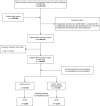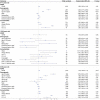Long-term bidirectional association between asthma and attention deficit hyperactivity disorder: A big data cohort study
- PMID: 36741570
- PMCID: PMC9893024
- DOI: 10.3389/fpsyt.2022.1044742
Long-term bidirectional association between asthma and attention deficit hyperactivity disorder: A big data cohort study
Abstract
Background: Previous studies have argued that attention deficit hyperactivity disorder (ADHD) is associated with asthma. However, reliable evidence to verify this association has not yet been reported.
Objectives: To investigate the bidirectional association between asthma and ADHD through a 12-year big data cohort study.
Methods: The independent variable group was extracted from 3.5 million individuals randomly sampled by the National Health Insurance Service (NHIS). In Study 1, the incidence of ADHD according to asthma was evaluated, while in Study 2, the incidence of asthma according to ADHD was analyzed. Propensity score (PS) matching with several variables was used to obtain a control group.
Measurements and main results: In Study 1, the asthma group included 131,937 individuals and the non-asthma group included 131,937 individuals. The adjusted hazard ratio (aHR) for ADHD in the asthma group was 1.17 [95% confidence interval (CI): 1.11-1.23]. In subgroup analysis, the aHRs for ADHD of individuals in the subgroups male sex, 0-5 years old, 6-10 years old, atopic dermatitis, allergic rhinitis, Charlson comorbidity index (CCI) 1, and CCI > 2 were significant (aHR: 2.83, 1.70, 1.79, 1.09, 1.15, 1.06, and 1.49, respectively). In Study 2, ADHD was found to significantly affect asthma in all age groups (aHRs of the subgroups 0∼60 and 0∼17 years old were 1.10 and 1.09, respectively). In the 0∼17 years old subgroup, the association of ADHD with asthma was greater with younger age (aHRs of the subgroups 0∼5 and 6∼10 years old were 2.53 and 1.54, respectively).
Conclusion: From long-term follow-up, the incidence of ADHD was 1.17 times higher in the asthma group than in the control group. The incidence of asthma was 1.10 times higher in the ADHD group than in the control group. Asthma and ADHD have a bidirectional relationship, and childhood asthma and ADHD should be rigorously managed.
Keywords: ADHD; National Health Insurance Service (NHIS); asthma; cohort study; psychiatry.
Copyright © 2023 Park, Kim, Na, Jeong, Lee, Lee, Yang, Kang, Yeom and Kim.
Conflict of interest statement
The authors declare that the research was conducted in the absence of any commercial or financial relationships that could be construed as a potential conflict of interest.
Figures





References
LinkOut - more resources
Full Text Sources

